M.V. Britannic 1930 to 1960 - Page One
Please Note: Firefox and some other Search Engines may not be suitable
Use Google Chrome for this Web Page to load perfectly!
Please Note: All ssMaritime and other related maritime sites are 100% non-commercial and privately owned, thus ssmaritime is NOT associated with any shipping company or any other organisation! Although the author has worked and been involved in the passenger shipping industry for well over 60 years, but due to his old age and poor health, he was forced to retire. Yet, he has completed well over 1,435 Classic Liners, Passenger-Cargo Liners as well as humble converted C3 converted Migrant Liners, which has transported countless thousands of folk to the new world, as well on vacations’. Amazingly, ssmaritime.com has received 573.4 million visitors to date I trust the features online will continue to provide Classic Liner and Ship enthusiasts both the information they are seeking, but more so provide a great deal of pleasure and relive many happy memories!
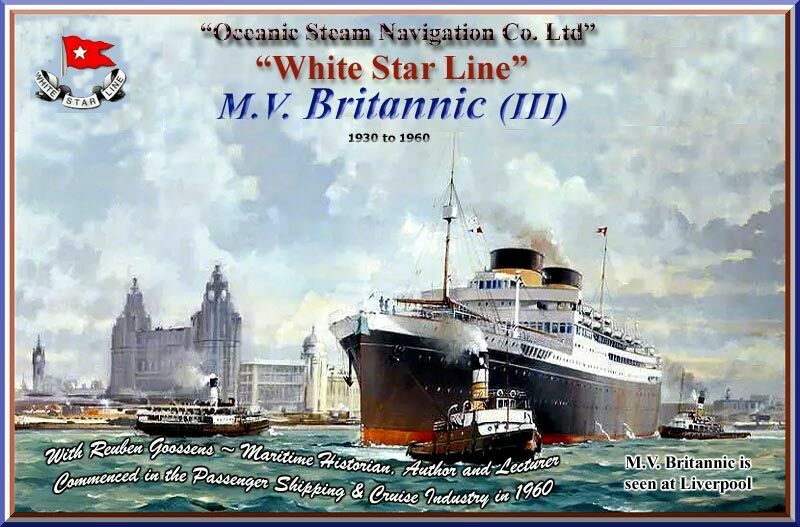
Please Note: Postcards, photographs & other images are either from the author’s private collection or from my supporters.
Thus a very thank you to the following ssmaritime supporters for sending me their wonderful
photographs & images for I could not have completed this feature to this point.
+John
Savage (
I am sorry but some of the images shown may not be of the highest quality, but they are the best that were available
Page One
Please Note: Due to the size of this M.V. Britannic feature, I had to divide it into two pages, thus on Page One I will cover her early years, from construction, launching, and her maiden voyage. Next we take a look at her interiors and exteriors, as well as her Trans-Atlantic voyages, etc until 1939. Part Two contains her duties during World War Two, her post war refit, with a look at her new ‘Art Deco’ interiors, and her final days at sea, operating both Trans-Atlantic services and her annual cruises until late in 1960, concluding with all her “Specifications & Details”, etc.
*********************
Three ‘White Star Line’ Ships named “Britannic”:
It all started in 1874 with the 5,005 GRT S.S.
Britannic (1) being an attractive three masted, two tall funnelled, sail and
steam ship. She offered accommodations for 220 in Saloon Class and up to 1,500
Steerage passengers, with a crew of 150. The “Britannic” set
out on her maiden voyage on June 25, 1874 from Liverpool to
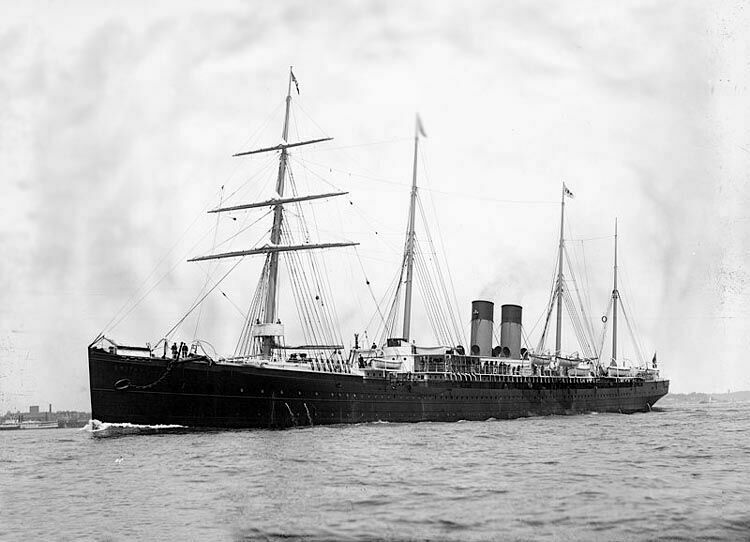
S.S. Britannic 1 - 1874
Then came the 48,185 GRT S.S. Britannic (2) of 1915 was the third and the last of the White Star Line’s ‘Olympic Class’ trio of ships, being the R.M.S. Olympic”, and the ill-fated R.M.S. Titanic. She was completed in 1915, but she never entered into her passenger services, but instead she was converted into a hospital ship and serve during WW1. Sadly on November 21, 1916 she hit a mine which caused a huge explosion that caused her to sink in due course. Out of the 1,066 people onboard, 1,036 people thankfully survived the sinking but sadly thirty men lost their lives in this disaster yet only five were actually buried; the others were not recovered and are honoured at memorials in Thessalonica. Her story is also on ssmaritime.com and the link is at the bottom of the page.
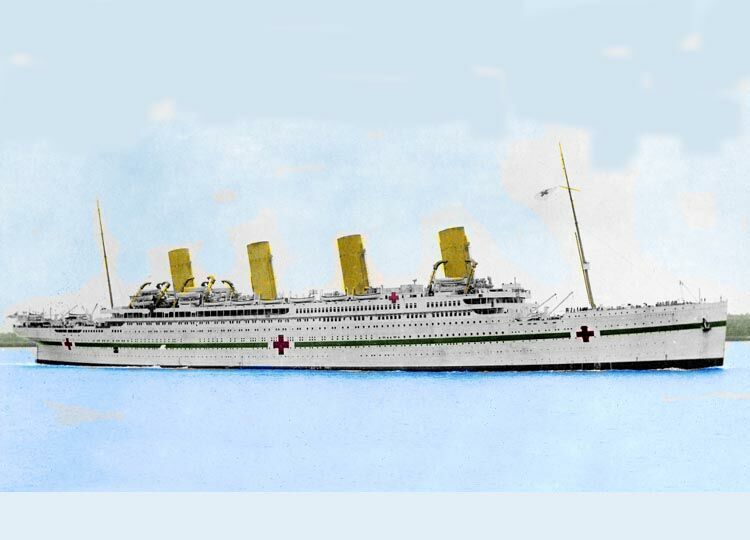
H.M.H.S. Britannic 1915
Although the M.V. Britannic (3) did serve during World War 2, but thankfully she survived and she returned to her old duties until a good old age. Of course her running mate was her newer sister by two years, the M.V. Georgic, but she was broken up much earlier.
*********************
The Building of the Motor Ship “Britannic”:
We need to understand that originally the “White Star Line” was planning to build two new liners to replace their ageing fleet, both of these ships were going to be motor-ships rather than more the traditional steam-ships: the first was to be around an 1,000 ft long ‘super-liner’ with three funnels and it was going to be known as the “Royal Mail Motor Vessel” or the R.M.M.V. Oceanic.
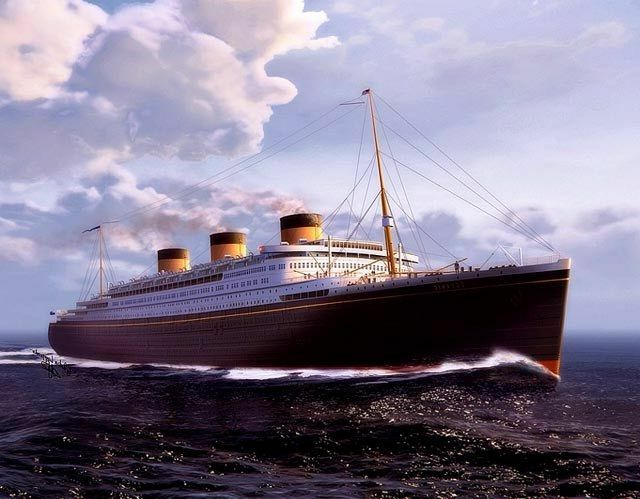
The R.M.M.V. Oceanic, a ship that never was!
There was also going to be a smaller more economic liner of a very similar design but with two funnels. However, the “White Star Line” decided to not go ahead with the “Oceanic” thus they decided on the smaller two funnel liner, which would become the M.V. Britannic.
On January 1, 1927 the “International Mercantile Marine Company” sold “White Star Line” to the “Royal Mail Steam Packet Company” (RMSP). At the time ‘White Star’ had one new steamship on order, the “Laurentic”, and they had been discussing designs with ‘Harland and Wolff’ for a proposed 1,000-foot liner, but overall the White Star fleet realized that they needed modernising.
Motor ships were far more economical than steam, and in the 1920’s the maximum size of marine diesel engine had increased rapidly. RMSP had recently taken delivery of two large motor ships, “Asturias” (1925) and “Alcantara” (1926), and chose diesel to replace ‘White Star’s’ “Big Four” liners. The replacements were to be smaller than the Big Four but more luxurious.
When ‘White Star Line’ had had completed the plans for the two new liners the “Britannic” and also her twin sister the “Georgic” they placed their order for their first ship to be built, being the “Britannic” early in 1927.
Then, on April 14, 1927 ‘Harland and
Wolff’ laid “Britannic’s” keel in its
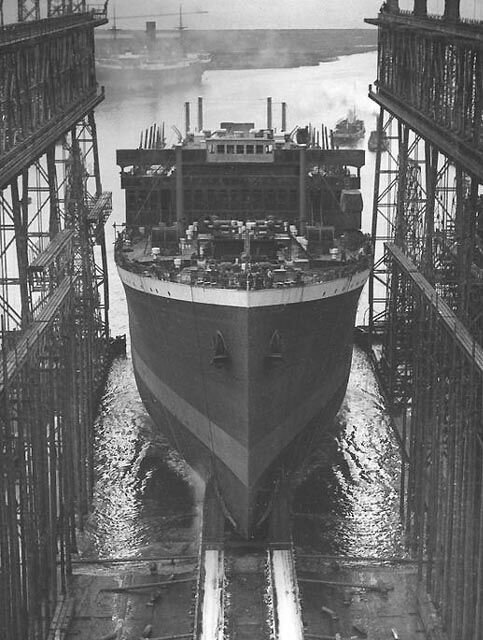
*Above & below: The “Britannic” is seen sliding down the slipway
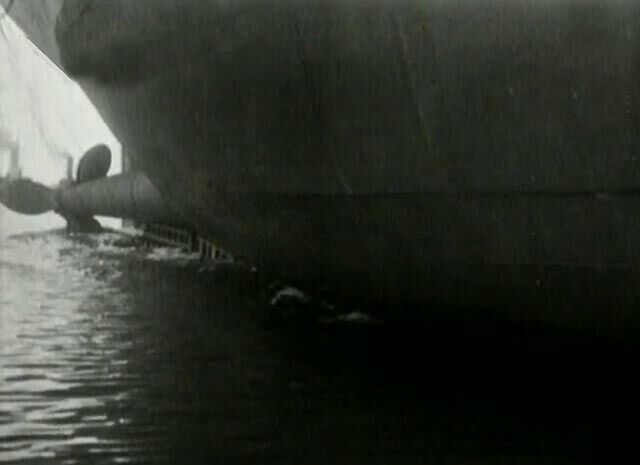
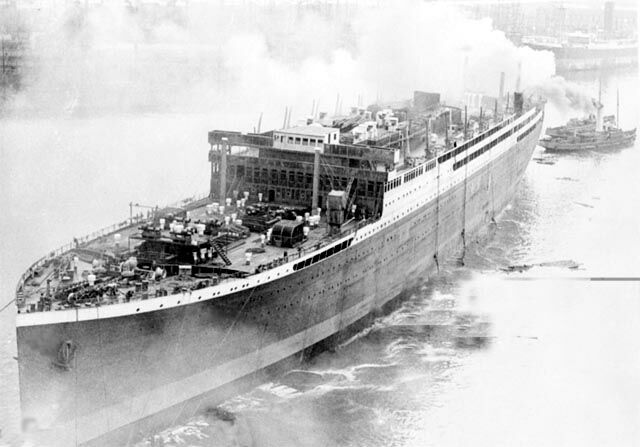
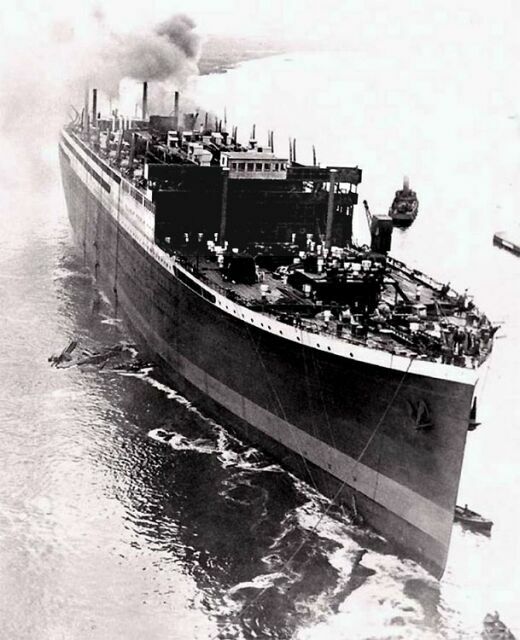
*Here we see her entering the water and tugs will take her in tow and
she will head for the builders fit-out berth where she will be completed
Her Sea Trials:
When completed, she commenced on her sea trials on May 27, 1930, for three days. Her trials were deemed to be successful managing a maximum speed of 18.4 knots.
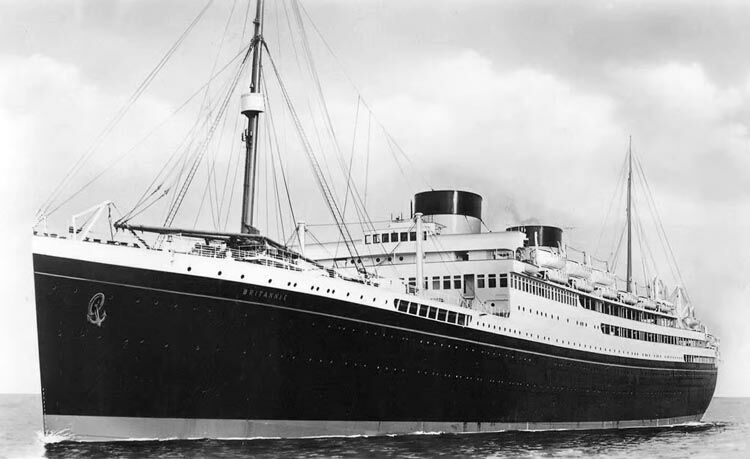
*She is seen during her sea trials on May 28, 1930
At the completion of her trials, she was
deemed to be ready for service and she was delivered to the “White Star
Line” in
Shipboard Information:
M.V. Britannic was built as a “Cabin Ship” with berths for 1,553 passengers: 504 in Cabin Class, 551 Tourist Class & 498 in Third Class. She had a Gymnasium, and a magnificent indoor Swimming pool. Her Cabin Class Public Venues were simply staggeringly beautiful, and the Dining Saloon was in the ‘Louis XIV’ style.
The “Britannic” was driven by a five-cylinder four-stroke double-acting Burmeister & Wain diesel engines. Between them the two engines developed 4,214 NHP, and with her two propellers this gave her a service speed of 17.5 knots. When new, the “Britannic” was the largest motor ship in the UK Merchant Navy and the second-largest in the World, she was second only to the Italian liner the “Augustus”.
M.V. Britannic had eight holds, one of which could carry unpackaged cars. With two holds being fully refrigerated and her total refrigerated capacity was 72,440 cu ft (2,051 m3). Twelve bulkheads divided her hull into watertight compartments. Their watertight doors could be closed either electrically from the Bridge, or manually. In total, installed were 24 lifeboats, as well as 2 motor boats and 2 backup boats.
The “Britannic” had two funnels and as on many of the early ‘Harland and Wolff’ motor ships, they were low and broad. However, only her aft funnel was in-fact an exhaust funnel, for her forward funnel was a dummy which housed amazingly two Smoking Rooms: one was exclusively for her Deck Officers and the other for her Engineer Officers. It also contained water tanks, and later during her career it contained the radar equipment.
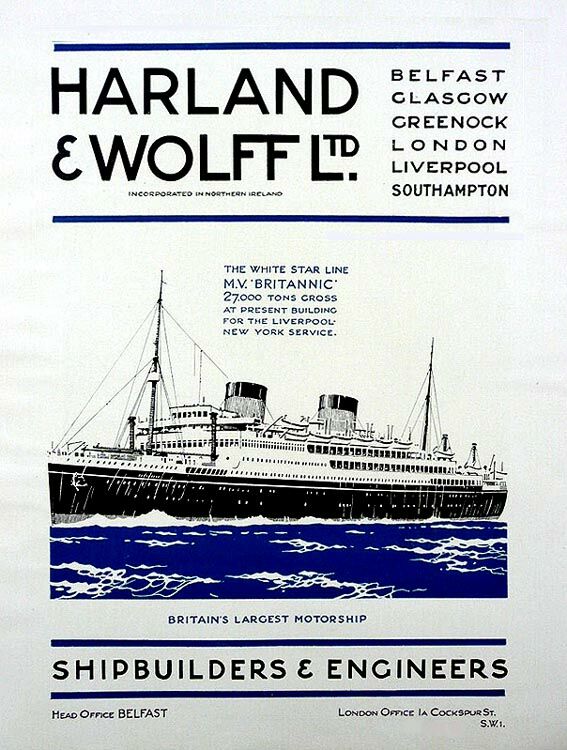
An ‘Harland and Wolff’ detailing the M.V. Britannic after she had been completed, but prior her maiden voyage
The “Britannic” was painted in the traditional ‘White Star Line’ colours; thus she had a black hull with a thin gold line high up her hull, a white superstructure and ventilators, red boot topping, buff funnels with a black top.
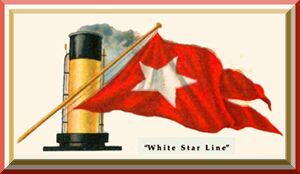
Both the “Britannic” and the “Georgic” retained their ‘White Star’ colour’s even after ‘White Star’ merged with ‘Cunard’ in 1934, and flew the ‘White Star Line’ House Flag to the very end of their days!
*********************
Delivery and Maiden Voyage:
M.V. Britannic departed
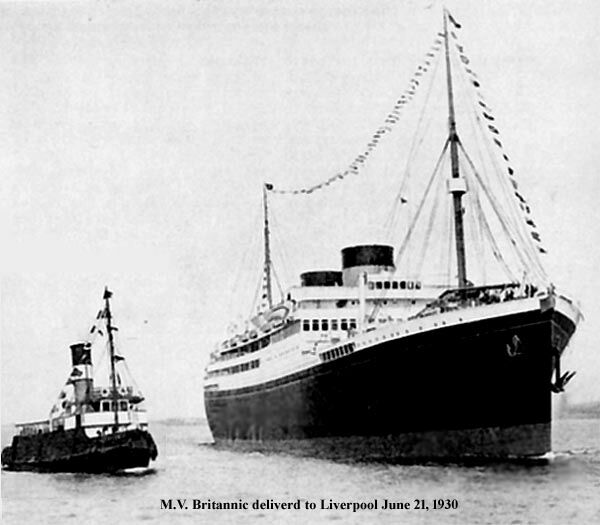
It only took 7 days to fully crew her and stock the ship up and make her ready for departure and then came the big day, for she departed Liverpool on June 28, 1930 on her maiden voyage to New York.
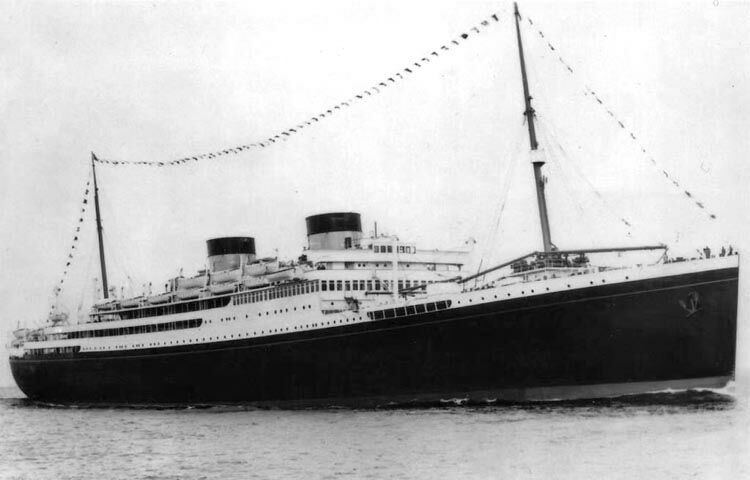
^M.V. Britannic is seen having departed on her maiden voyage on June 28, 1930
Amazingly an estimated 14,000 people turned
out at
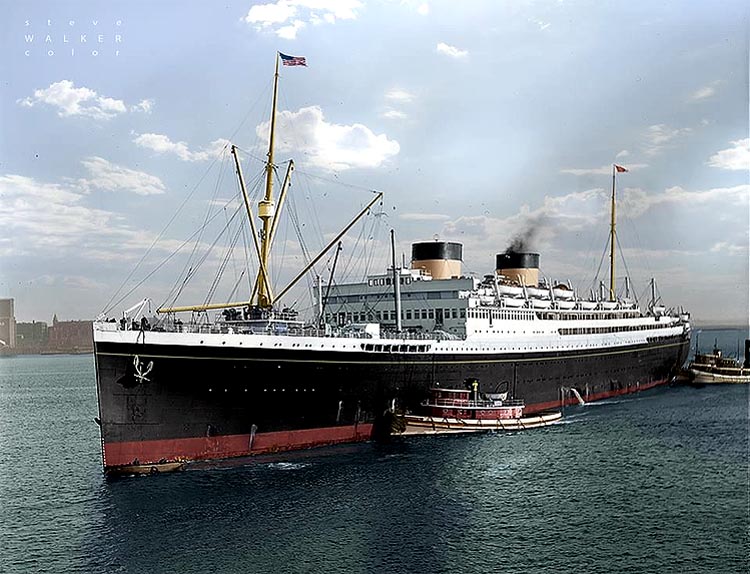
^As she neared the city fire tugs came near and sprayed water spouts to welcome the new liner to NYC!
Over the next few days, around 1,500 people paid $1 each to board and visit the ship while she was in port, and on July 12 a crowd of more than 6,000 came to see her depart New York for Cobh and Liverpool.
For her first three voyages the
M.V. Britannic’s speed was limited to 16 knots until her engines
were run in. Thereafter her speed was increased, and at the beginning of
October 1930 she averaged 17¾ knots on a westbound crossing. Then on
an eastbound crossing in July 1932 she averaged 19¼ knots beating her own
record. She was operating on the; Liverpool, Cobh,
A Tour of the M.V. Britannic:
We are about to take a tour of the “Britannic” and as always, we will commence from forward of the ship, topside and we will always slowly head aft and then go down a deck and commence again from forward on that deck, etc.
Bridge Deck:
This deck only housed the Bridge far forward atop of the ship, with the bridge wings on both sides were mostly used for departures when departing and berthing, as well when an officer or crew member used the sextant to obtain a bearing. The only other facility was the chart room, which was just aft of the Bridge.
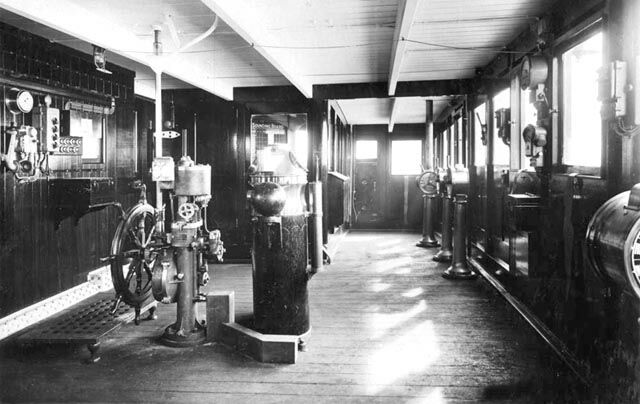
Above & below: The Bridge and a senior crew member using the sextant
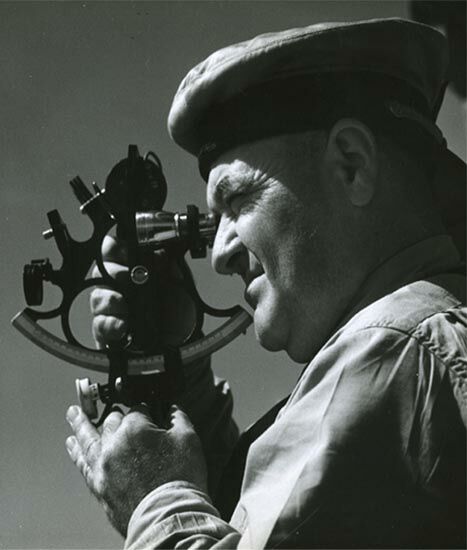
Cabin Class
Boat Deck:
Forward on boat deck was the Captains quarters and his office, as well as the officer’s accommodations, and their lounge and dining room and their general facilities, etc. The Radio Room was also located on this deck. As I mentioned earlier the forward funnel contained two Smoke Rooms; one was her Deck Officers and the other for her Engineer Officers.
Apart from the aforementioned, Boat Deck was a popular walking deck as well as a place to meet and chat fellow passengers on a pleasant day!
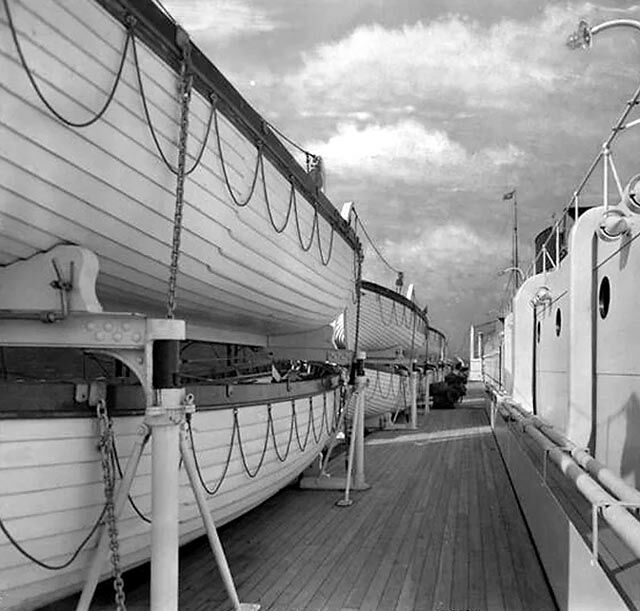
Looking aft along the starboard side of Boat Deck
Further aft was a broad open Sports Deck stretching the full width of the ship. Marked out for deck games was a tennis court with a net and a shuffle board locations and these were protected from the headwinds. Other areas offered deck chairs for relaxation.
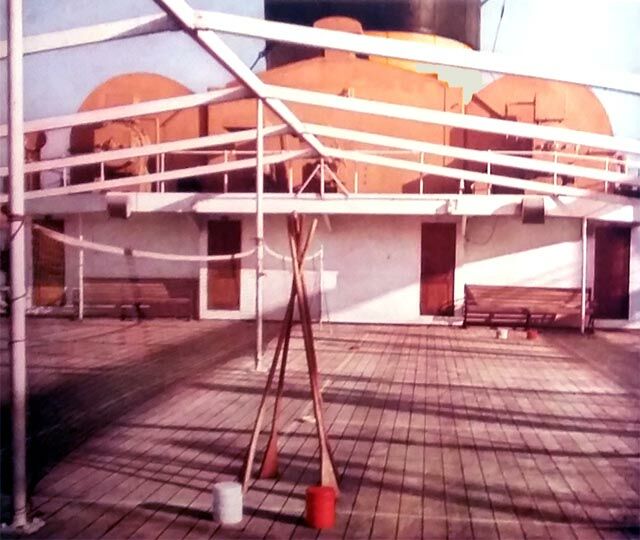
^Sports Deck
Promenade Deck:
The Card Room:
Far forward is the staggeringly beautiful Card Room with its grandiose fireplace in the centre of the aft wall. The room features elaborate timberwork along the walls and on the massive decorative ceiling works, the floor features original Persian carpets, and the luxurious deep comfortable lounge chairs and the sofa at the fire place were beautifully upholstered in luxurious upholstery and suede. There are several windows along both sides and a wall of windows along the entire front of the room overlooking the foc’sle of the ship.
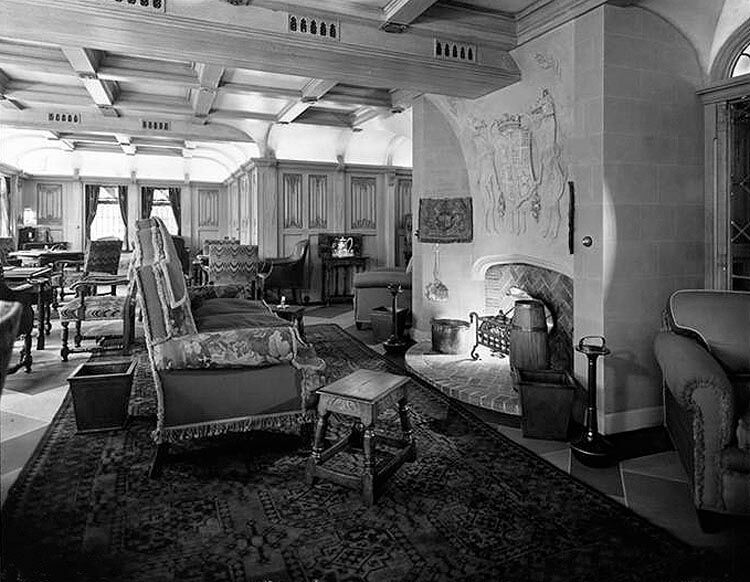
The magnificent
Directly aft of the Card Room is the Cabin Class Main Lobby, which along the forward wall has two stairwells on both sides of the lobby which went down as far as C deck and the Main Dining Room. The elevator (lift) was located in the middle. At the sides of the lobby were the doors that opened out onto the Promenade Deck. Along the side walls and the door outside, as well as on the centre forward wall were comfortable locations for seating, as well as aft wall in the middle. Also on the aft wall were two large doors into the magnificent Lounge.
The Lounge:
Excluding the dining room, this was the largest venue on board the ship, and it was magnificent being two levels high with its huge square dome in the centre, which featured intricate murals on its three sides. Its ceiling had a huge timber and panelled glass lighting feature with other delicate decorative finishing’s. There were elegant ivory coloured columns along the edge of the dome, whilst the floor below was covered in a huge Persian carpet. The sides of the lounge had nine large arched windows with beautiful silk drapes. The furnishings in the lounge were of the highest quality and comfort with the Lounge chairs and sofas featuring the finest floral tapestries and the timbers used in them, including the tables were in mahogany.
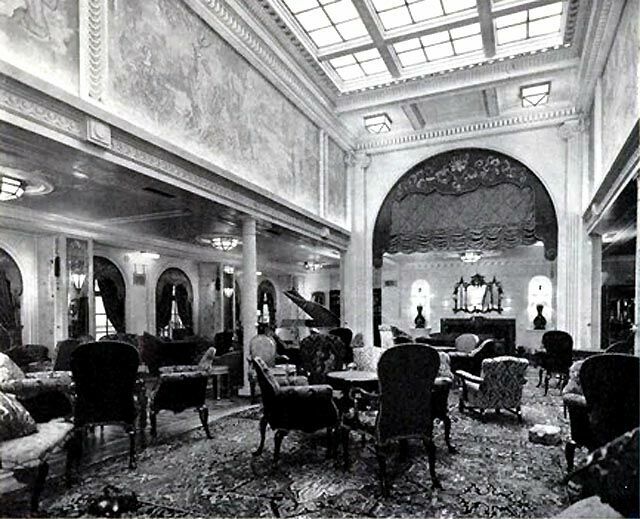
The spectacular Lounge
Aft towards the starboard side stood a Grand Piano and along the aft wall centre was a huge Arch with a superb deep red decorative feature on the top and this beautiful alcove could be used as a bandstand or other uses, including showing movies.
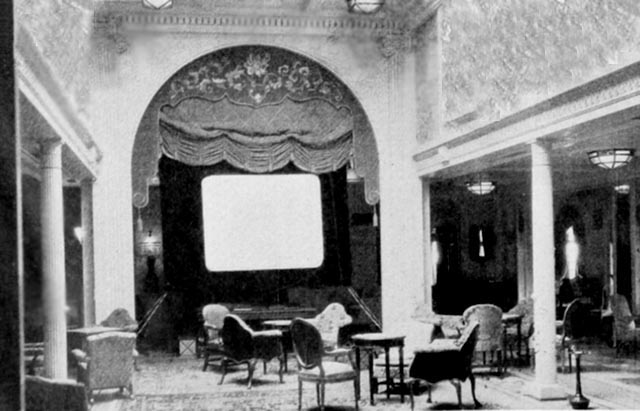
The Lounge is seen for showing movies
The Long Gallery:
Aft of the Lounge, on the portside you arrived into another beautiful venue being the Long Gallery. The Long Gallery had two very large bay windows at either end, as well as four smaller flat windows with one larger flat window in the very middle of the venue. Both sides are beautifully furnished with some of the lounge chairs heavily carved and sublimely upholstered, with other less so, but still with similar upholstery. Tables and cabinets in this venue are either in an ivory finish or in a dark timber finish. Ivory coloured columns are located at the beginning and the end of the gallery, and unlike the earlier venues the Long Gallery has a more modern style of carpet.
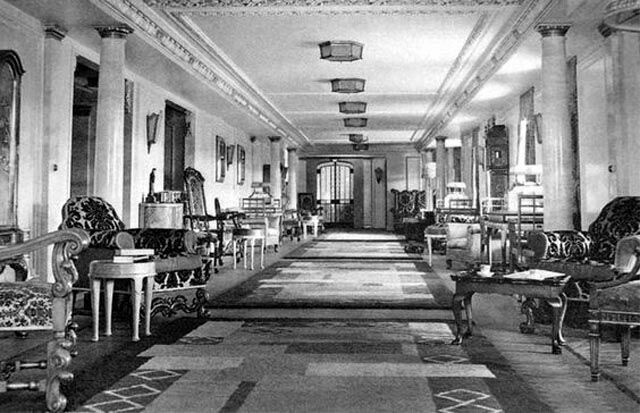
The popular Long Gallery
Other venues on the Starboard Side:
Around a third of the way into the Long Gallery on the left is a lobby with a stairwell in the centre that goes down as far as B Deck, but this lobby also leads to the Children's Playroom at the end located forward. There is also a door heading outside. The lobby turns aft where were there public facilities, and then there is the Drawing Room.
The Drawing Room:
This venue can only be described as simple elegance the venue is all in an ivory tone and has that look of yester years and a room of a grand mansion. It has a fine fireplace, mahogany furnishings, but upholstered in light tones, with some in floral brocades. This venue is one that is one of peace and reflection.
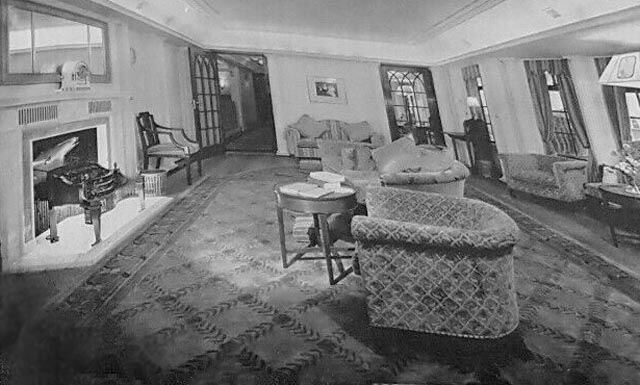
^The delightful Drawing Room
The Smoke Room:
Aft of the Long Gallery is the last Cabin Class Lobby with door out to the Promenade. However here we fine the entrance to the ever popular Smoke Room, something of course that no longer exists on ships today! But in those days it was the norm and this venue was one of the most popular and it was also the main Bar of the ship.
Traditionally it is usually a well timbered
venue and this time it had a floor covered in slate tiles of several colours,
and in certain section there were Persian carpets. As was usual in all Smoke
Rooms there was a
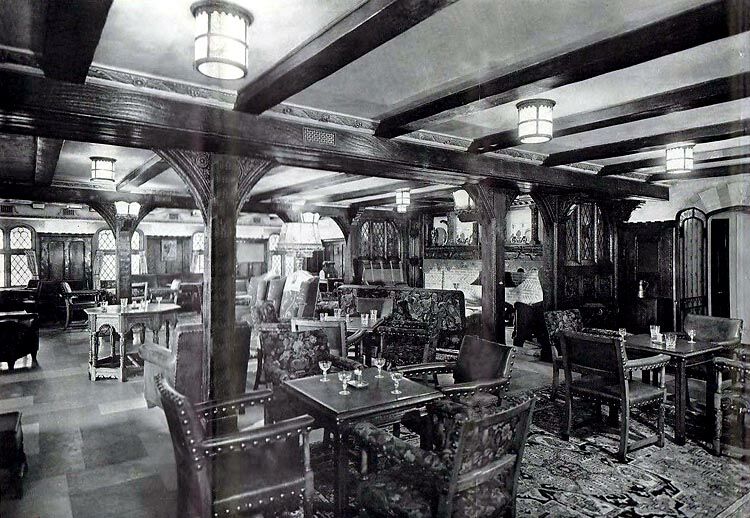
The magnificent Smoke Room
The windows arched, and timber posts held up the decorative ceiling timber features. Furnishings were in all mahogany covered with in the finest of what by now would seem to be the very best of the “Britannic” style of floral tapestries. This was just another very stylish and a much loved venue!
Promenade Deck:
This fine deck was a full walk-around deck and fully covered as well as glass enclosed up to two thirds of the Lounge area. It was wide and perfect for relaxing in a deck chair and enjoying a morning cup of tea, coffee or that popular cup of hot bullion. Read a book or have a chat with a new found friend. I am sorry no photographs are available.
Verandah Café:
On the starboard side from the deck is the entrance to the Veranda Café, which is a delightful café. Nicely furnished with windows all around and there were double glazed doors on the centre aft of the structure, which would open during fine weather, providing a great view aft.
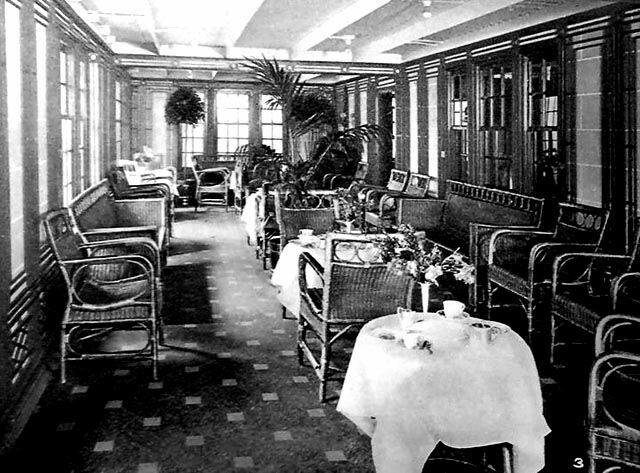
The Verandah Café
The Gym:
There was an open deck space aft and this was followed by a housing that contained Gymnasium with all the regular facilities. I have a crooked image, but it’s is the best I found.
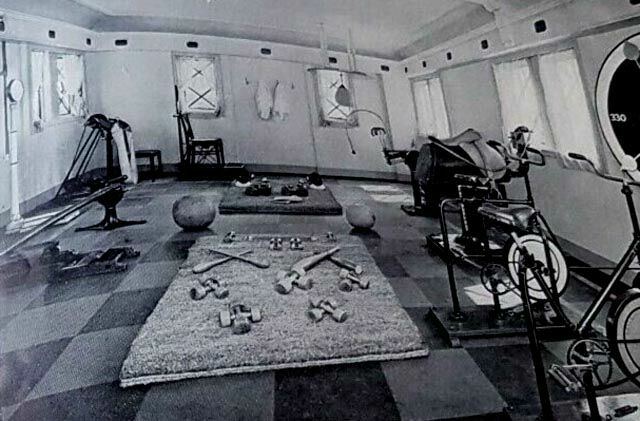
An illustration of the Gym
A Deck:
Accommodations & a Deck:
This deck, besides the Lobbies, contained two fine two roomed suites with private bathrooms, staterooms as well as cabins, from single bedded to twin bedded rooms.
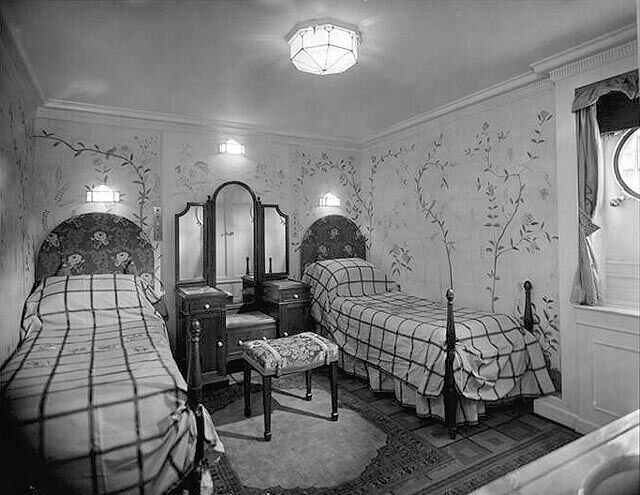
The bedroom of one of the Suites
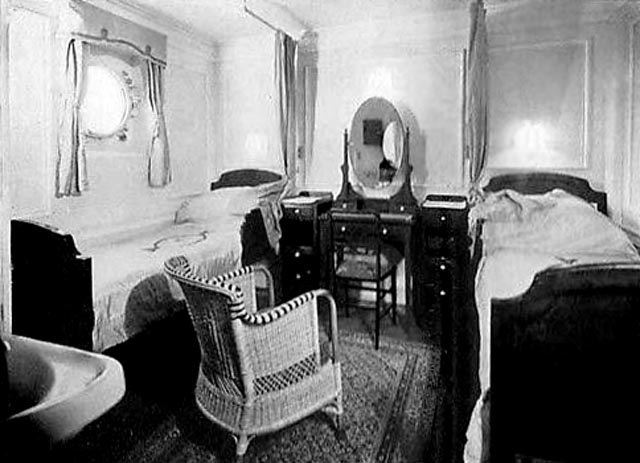
A typical Twin bedded cabin also on A Deck
All public female and male bathing and other facilities were located in the centre of the ship and were spotless at all times, there were also separate bathrooms. Further aft centred were the Ladies Beauty Salon and the Gents Hairdresser. Whilst half of the superstructure had another spacious fully covered promenade deck.
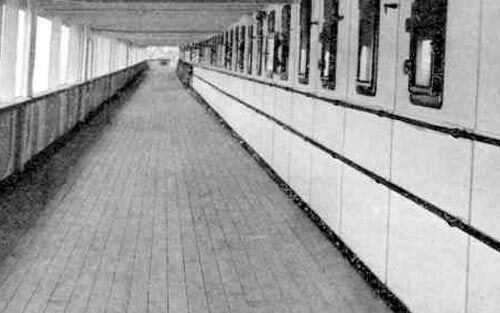
^The A Deck Promenade
B Deck:
Forward in the centre aft of the Elevator was the Passenger Shop, whilst the rest of this deck was again dedicated to cabins.
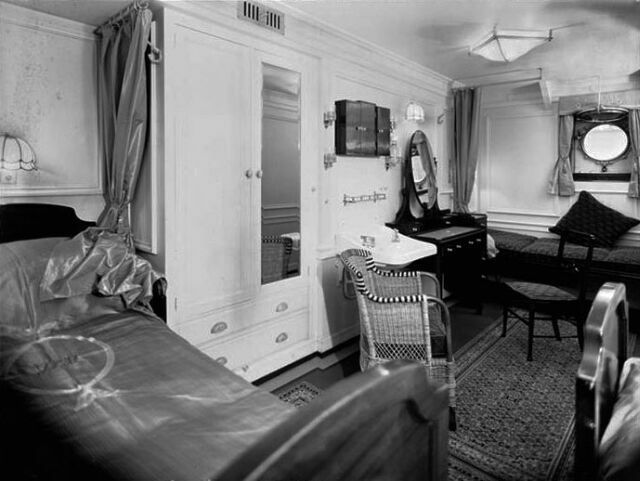
Here we see another single cabin on B Deck, but cabin
B-37 also had a sofa, that could be made up as a 2nd bed
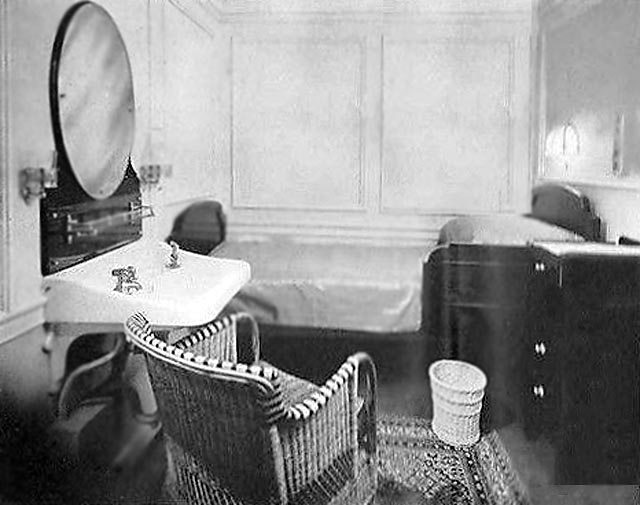
And this is a single bed cabin on B Deck
C Deck:
But I will first cover the Lobby, for it is the very first thing the passengers will see when they board, for it is the ships ‘Entrance Hall’. Thus it is pleasantly styled, although there is no photograph available, but there is one after her post War refit and we will see it on page Two.
The Dining Saloon:
The Dining Saloon was certainly a grand venue
and it was furnished in a distinctive “Louis XIV” style, whilst the
other venue’s employed styles such as the “Tudor”,
“Palladian”, and the “
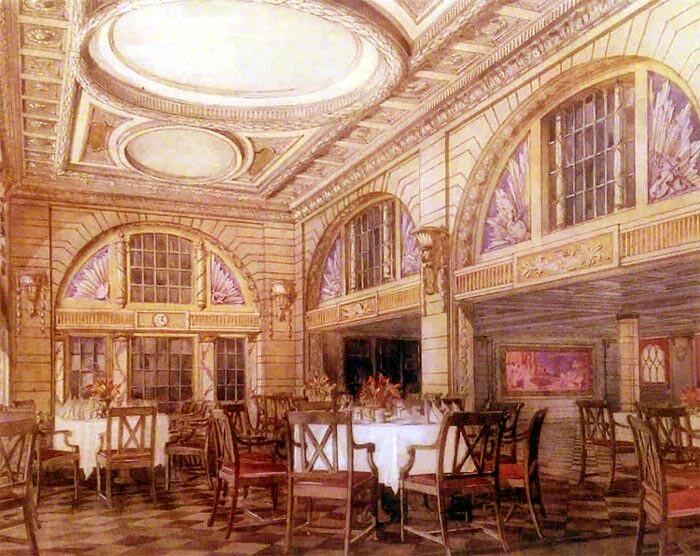
The spectacular “Louis XIV” style glamorous Dining Room
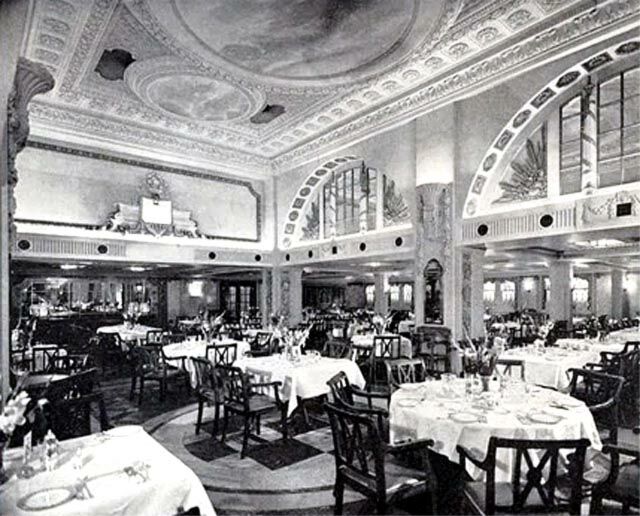
Above & below: Two further views of the Dining Saloon
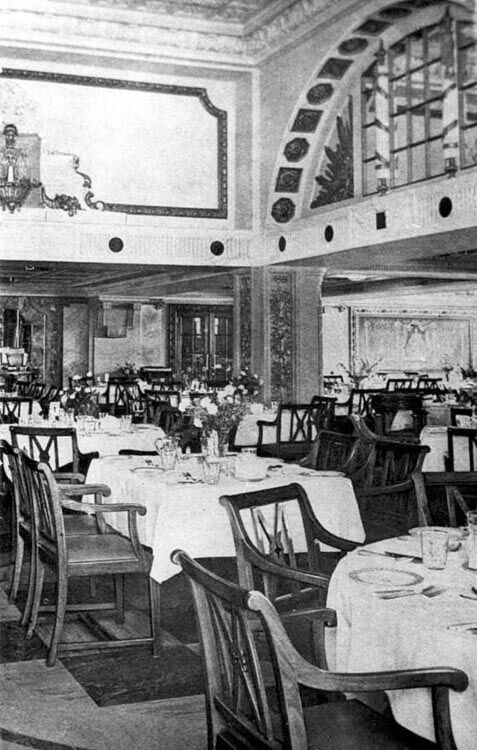
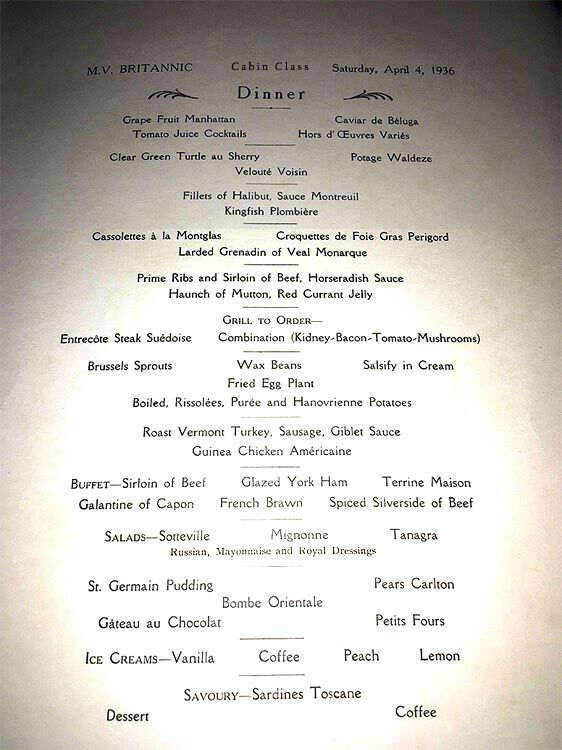
A Dinner menu from April 4, 1936
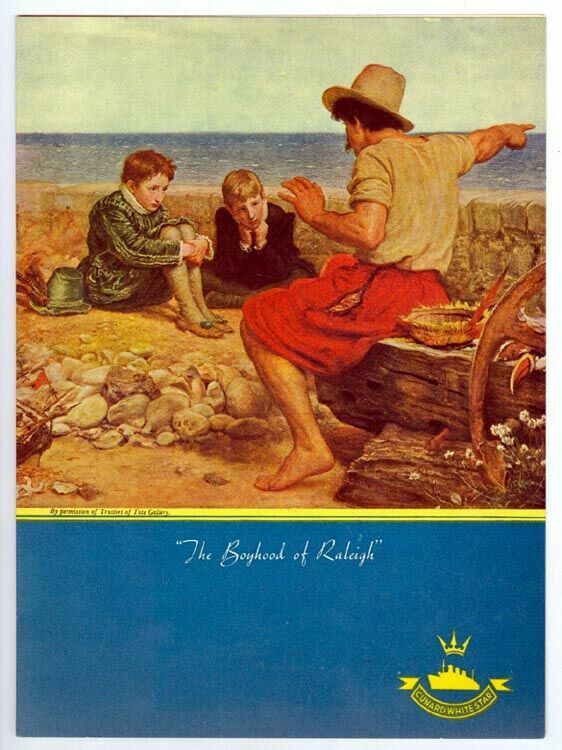 -
-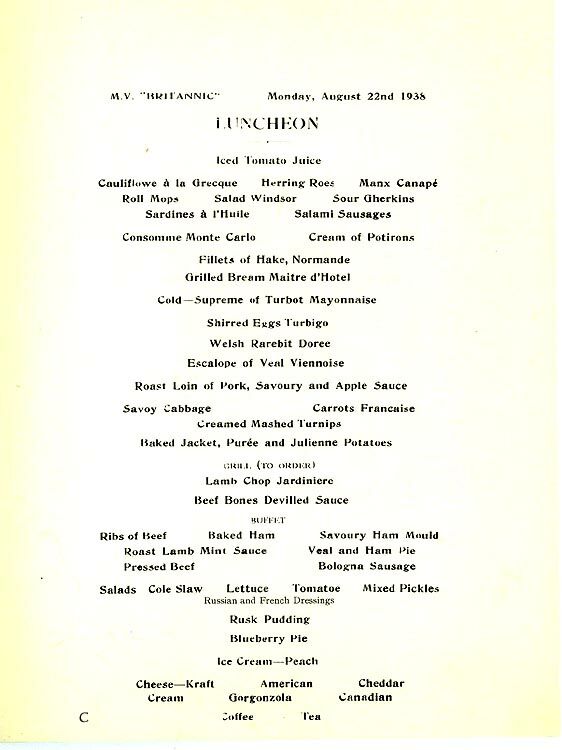
Lunch menu from August 22, 1938
E Deck:
This deck has just one very popular feature and that is the ships magnificent Indoor Swimming Pool. This is a grand venue, to say the least with art surrounding you on every wall, with grand square columns holding upward lights high up, as well as a ceiling of lighting. A fine marble mural is featured on the forward wall, whilst on the port side are countless change rooms.
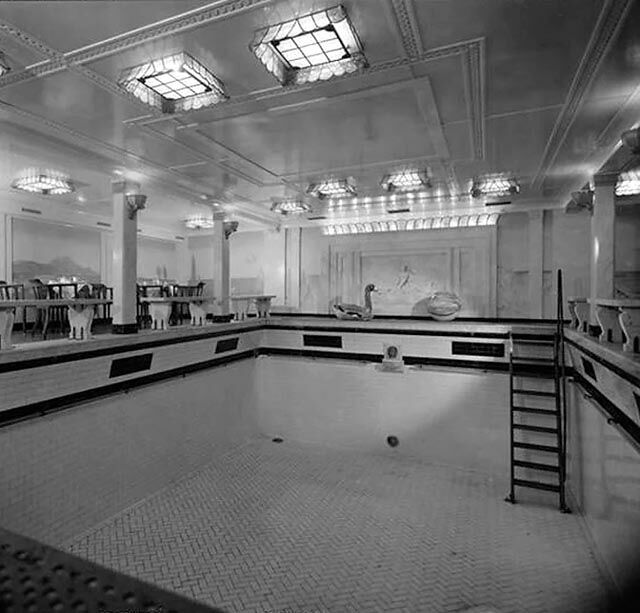
The Magnificent Pool
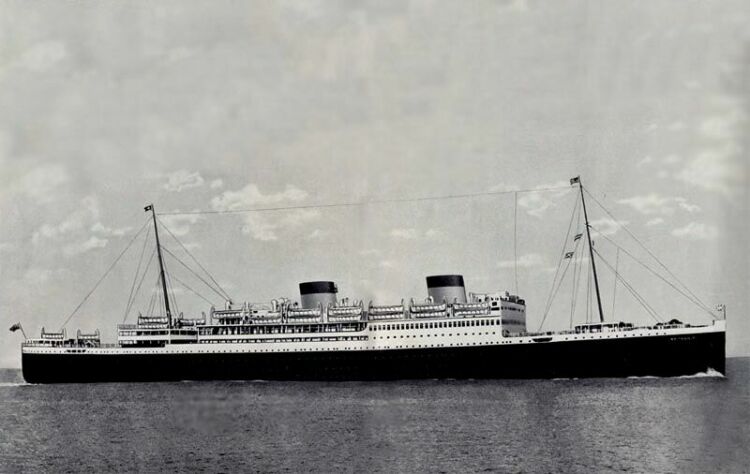
A fine view of the M.V. Britannic starboard side
*********************
Tourist Class
Sun Deck:
Sports Deck:
Aft of Promenade Deck there was a break due to there being a hold, but directly aft of this on the same level there was another deck, named Sun Deck part of Tourist Class facilities. This deck offered a tennis court and other deck games. The stairs were located on both sides aft which went down to A Deck.
A Deck:
Promenade, Drawing Room, Children’s
Playroom, Smoke Room:
Outside there is a full walk-around Promenaded Deck, but inside forward there is on the portside a fine Drawing Room with sofas along the walls and ample comfy chairs beautifully upholstered, with finely timbered furnishings, whilst on the starboard side is the children’s playroom. Between them are some facilities.
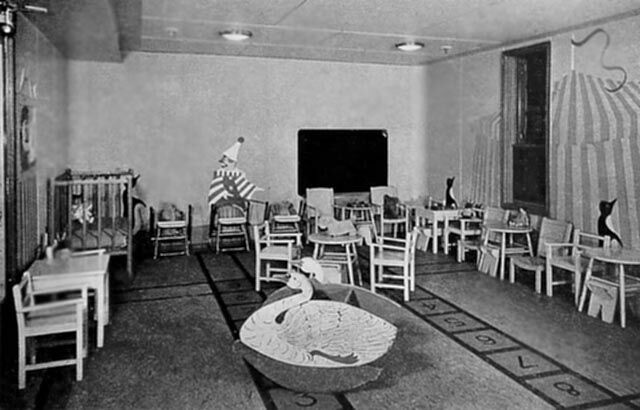
The Children’s Playroom
Aft of this housing contains the delightful Smoke Room and the Bar. This room is more contemporary in its décor with a ceiling that has been sculptured like large waves. The Bar is along the aft wall and windows on the three sides. The lounge chairs have a variety of upholsteries, from the traditional, to the more contemporary patterns, but the timber is all in the traditional mahogany.
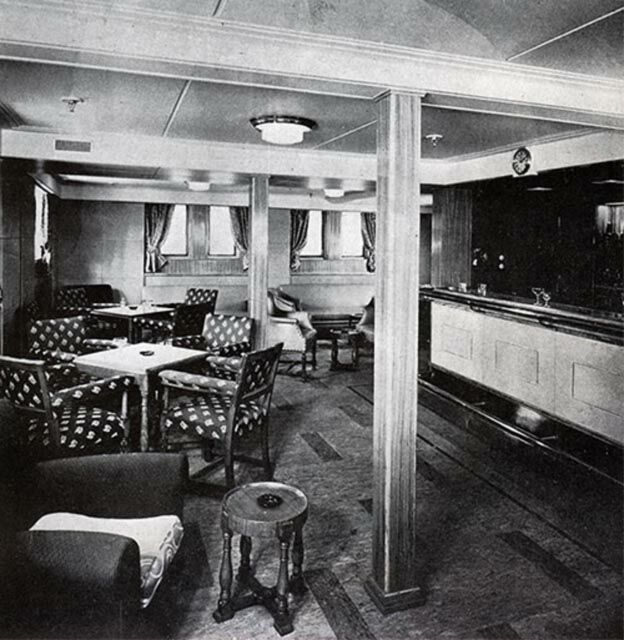
The Smoke Room
B Deck:
Forward of the Tourist section is the Lobby which has doors out to another promenade deck, and it is also their entrance hall, which also has the Information Desk and a shop. There are two sets of stairs going down to C and D Decks, for their Dining Room and accommodations.
The Lounge:
However on this Deck aft there are two further Public venues, the first directly aft of the Lobby was the delightful Lounge. It was well furnished, with the best of lounge chairs with beautiful floral upholstery, Mahogany tables of various sizes and wall panelling. It was a fine U shaped venue.
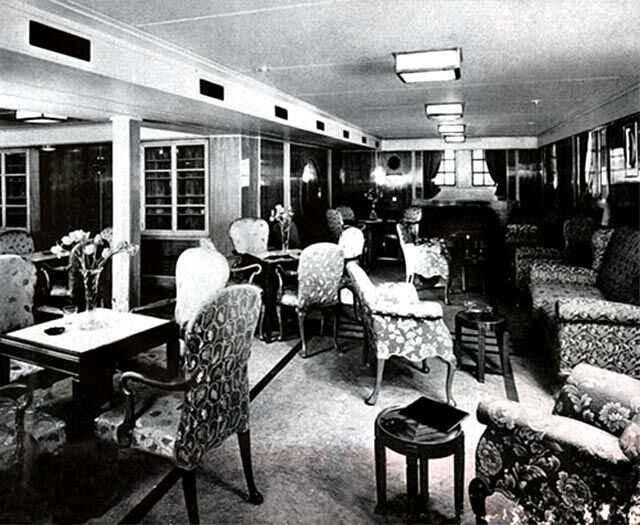
The Lounge looking aft along the portside
Outside there is a very spacious deck space, but amazingly just a little further aft is a second but a smaller Smoke Room, although no images are available of this venue. But like all Smoke rooms it had a Full service Bar!
C Deck:
This Deck has two Public venues, The Dining Room, and yes another smaller Lounge.
The Dining Room:
The Dining Room stretched the full width of the ship and was obviously very spacious indeed, as well as being a light and bright venue. It was pleasantly furnished and it offered tables for two, four, six, eight to 12 persons, it all depended on preference. The chairs were of same design as those in the Cabin Class Dining Room thus there was nothing cheap here as only the best would do, and that included the high quality of their menus!
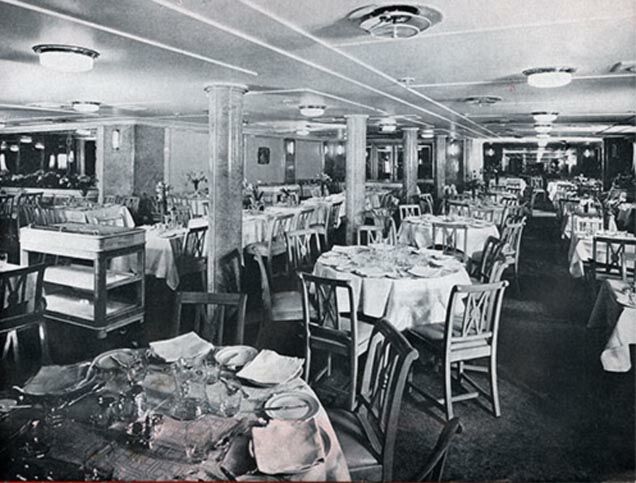
Here we see a side of the large Dining Room
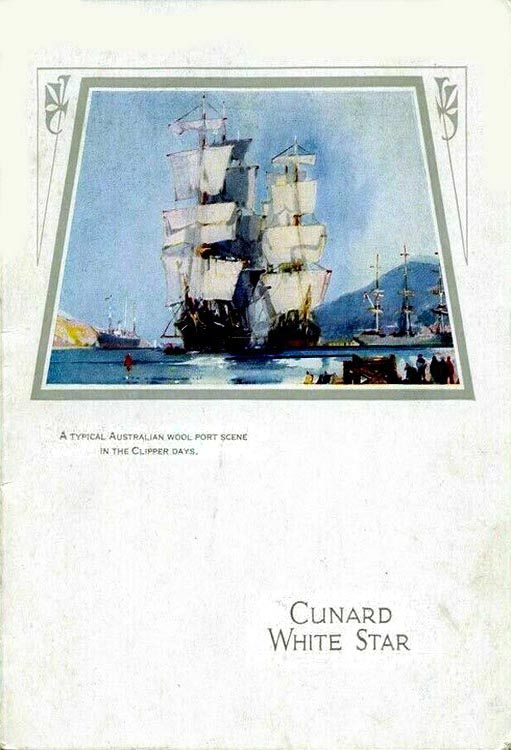
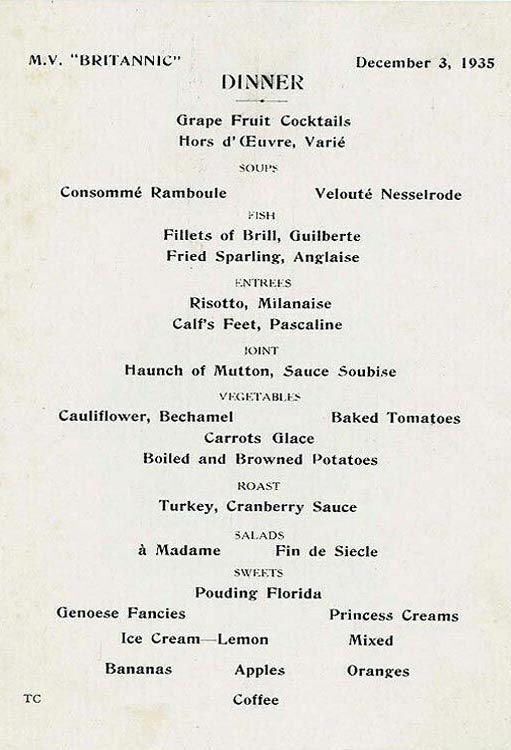
An excellent Dinner Menu served on December 3, 1935
Just slightly further aft on the portside was another somewhat more intimate rather square lounge, but very pleasantly furnished. However there are sadly no images available of this venue.
Staterooms:
This deck including D Deck contained all of the Tourist Class Accommodations, these were singles, twin bedded, some two being berth staterooms then there were some that could be sold as a three berth rooms.
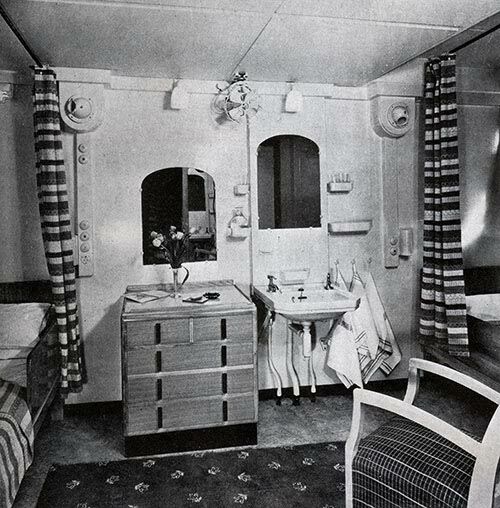
A typical tourist class twin bedded cabin
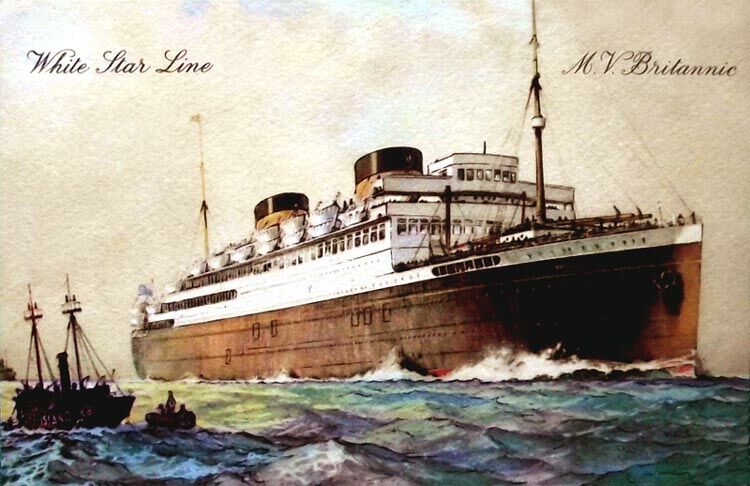
A postcard sold on board
*********************
Third Class
A Deck:
Third Class was located far forward in the bow section of the ship, and their top deck was A Deck.
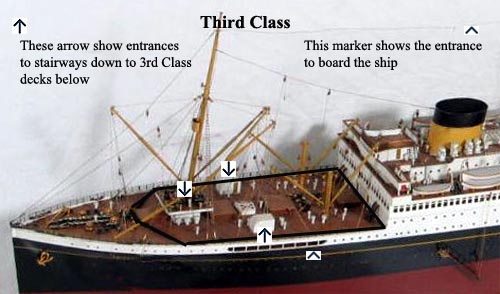
The Deck we see is the ships foredeck, (or A Deck) and it is also
The open Promenade deck for the Third Class passengers
A Deck was a spacious open Deck, allowing her passengers to enjoy the sun, or play various sports, and shuffle board was one of the most popular games, as obviously ball games were out as the ball would be overboard in a second. This was their only open deck where they could enjoy the sun and fresh air, etc.
B Deck:
Passengers would board the ship via the covered B Deck being under the Foredeck (A Deck) as shown in the image above. It was also a fully covered and a spacious Promenade which had ample deck chairs for relaxing, and again there was plenty of space for playing games. However on this deck there was an exceptionally fine Lounge!
The Lounge:
This Lounge was far from the usual Third Class venues, for it was really quite beautiful, not only was it superbly furnished and fitted out, but this room even had a square dome in the centre of the room with four glass panels allowing light to filter into the venue. The floors had large two tone marble tiles, with the finest Lounge chairs all superbly in the very same manner as up in the Cabin Class with the finest of floral and some in plainer upholsteries. The occasional tables were in beautiful mahogany, and there were four ivory columns at each corner of the dome. The forward wall was in a lighter timber finish, whilst the other three walls were in a lighter shade, but I am unable to distinguish the actual colour. The windows were arched and the door to the exterior in a dark timber.
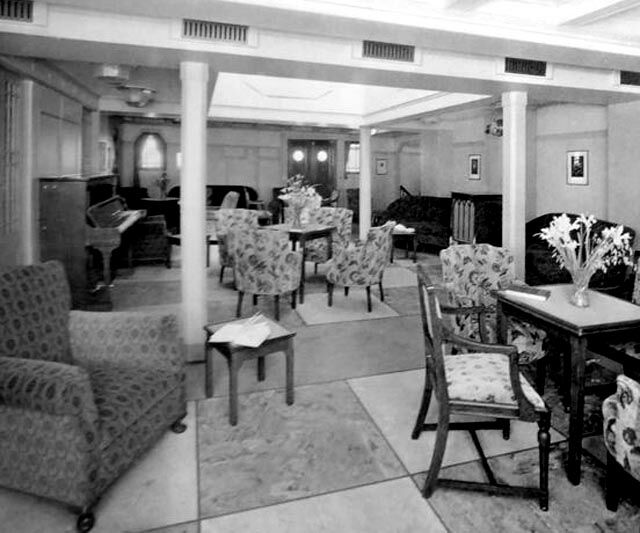
The Lounge
On the forward wall stood an upright piano and on the aft bulkhead there were two large sofas, with a fine cabinet between them and on either side of all this there were stairs down to C deck.
C Deck:
The port side stairs from the Lounge down to C Deck would take you directly to the Smoke Room, and we will visit this venue first.
The Smoke Room:
There was no doubt that the ‘White Star Line’ went out of their way to this class very inviting, for the public lounges certainly were far above all their completion! The Smoke Room had a very male feel, heavily timbered and a tiled floor and good Bar, all combined with the perfect furnishings to make it the best place to have a drink or two and meet your friends! Although I only have an illustration, there is also a picture of the Third Class plan below, although hard to make out, but it backs this illustration very well!
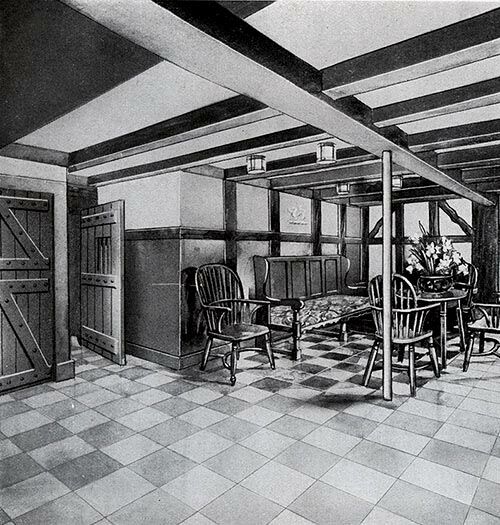
The Smoke Room
Another Lounge:
Directly opposite on the starboard side there is another small Lounge, although I have nothing on this venue, yet it ensured that there were ample locations for her 498 - Third Class passengers to relax in.
Beside this Lounge was the Children’s Playroom, which like in all classes offered every possible game and toy to play with and the nurses would take them up to B Deck for playtime.
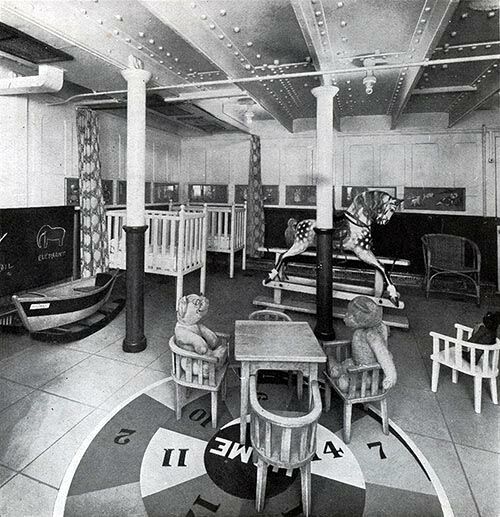
The Children’s Playroom
Most cabins on this and D Deck were two berth cabins and some were four berth cabins.
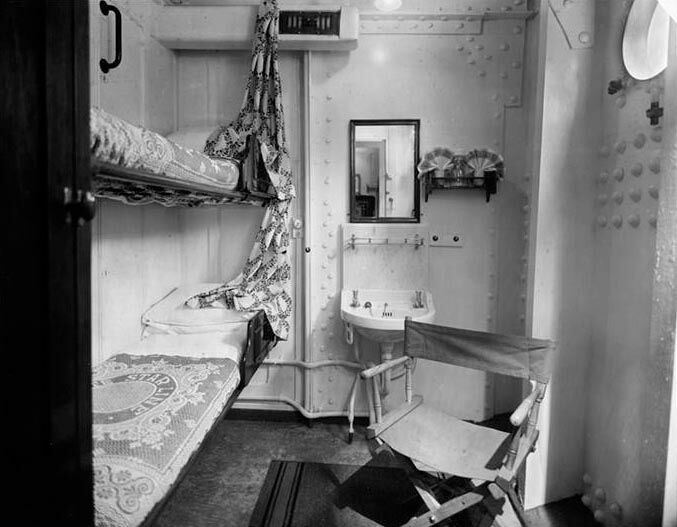
There is no doubt that the cabins were simpler that the other classes, but were well kept and always clean!
D Deck:
Besides there being many cabins on this deck the main feature was the large Dining Room that was located aft.
The Dining Room:
This was a large venue again the full width of the ship at its forward section, and it continued along the starboard side. Tables were all long and they seated six or eight each, although there were a few for four and five. Unlike other ships the chairs were not fitted to a steel post fitted to the floor and swivelled, thus every one sat on an actual wooden quality chair, therefore the venue was worthy of a fine meal! The walls featured art as well as murals, far from other ships that treated third class passengers like if they were “third class”. But on the M.V. Britannic they were treated like valued guests!
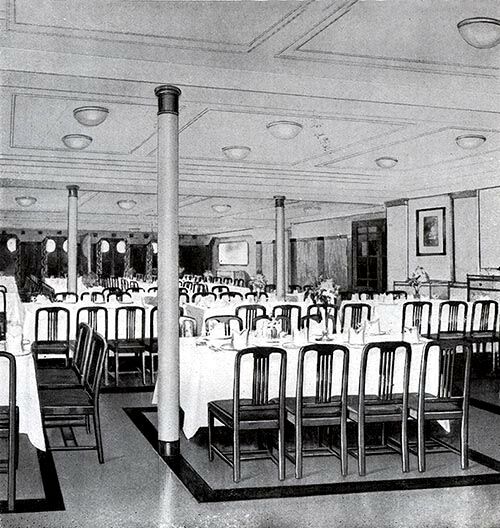
The Dining Room
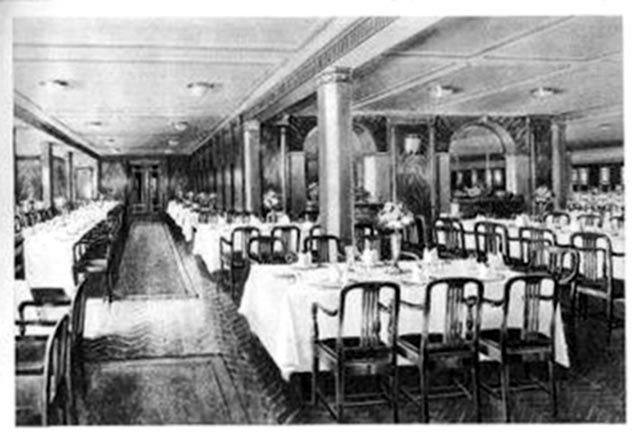
Another view from a ‘White Star Line’ Postcard
Typical Third Class Menus
Breakfast Menu:
Apples, Rolled Oats, Grape Nuts,
Post Toasties, Puffed Rice.
Fried Sole, Broiled Irish Ham,
Eggs (To Order) - Fried, Boiled, & Turned.
Hot Rolls,
Scotch Pancakes, Maple Syrup.
Preserves,
Marmalade.
Tea or Coffee.
Luncheon Menu:
Veal Broth.
Fried Fresh
Herrings, Mustard.
Stewed Steak
and Onions.
Carrots Paysanne.
Mashed
Potatoes.
Cold Buffet.
Roast Lamb.
Boar's Head.
Prim Ribs of
Beef.
Salad Americaine.
Baked Apples.
Cheese and
Crackers.
Tea, Coffee.
Dinner Menu:
Potage Favorite.
Poached Halibut, Hollandaise.
Roast Leg of Loin of Pork.
Savory and Apple Sauce.
Puree of
Turnips.
Boiled and
Roast Potatoes.
Fairy Cake.
(Milk Pudding for Children
if Required)
Ice Cream.
Dessert.
Third Class Cabin Plan:
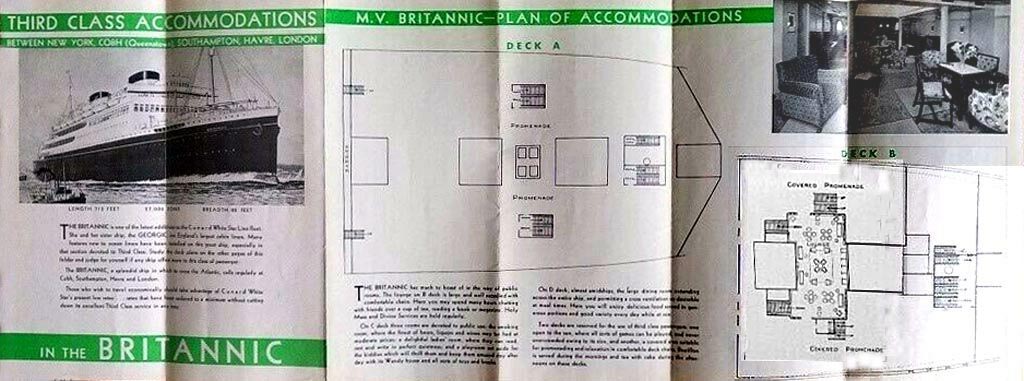

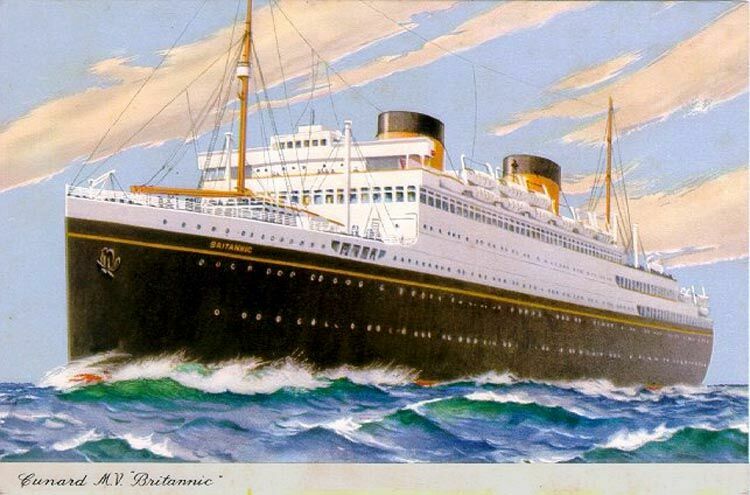
A fine colour postcard of the M.V Britannic
*********************
M.V. Britannic’s Service’s:
By the time Britannic entered service, sadly the Great Depression had caused a global slump in passenger numbers and in merchant shipping overall. Several ‘White Star Line’ steamships operated cruises for at least part of the year to make up for the fall in Trans-Atlantic passenger numbers. But Britannic’s lower running costs enabled her to make a profit on the service. In 1931 ‘White Star Line’ operated ten ships, but only four made a profit on scheduled services.
The “Britannic” fitted in
short and some longer cruises, between some of her scheduled Trans-Atlantic
crossings in 1931 and 1932. These were from just 2 and 4 day cruises to 16
and even to 28 days. All departed from
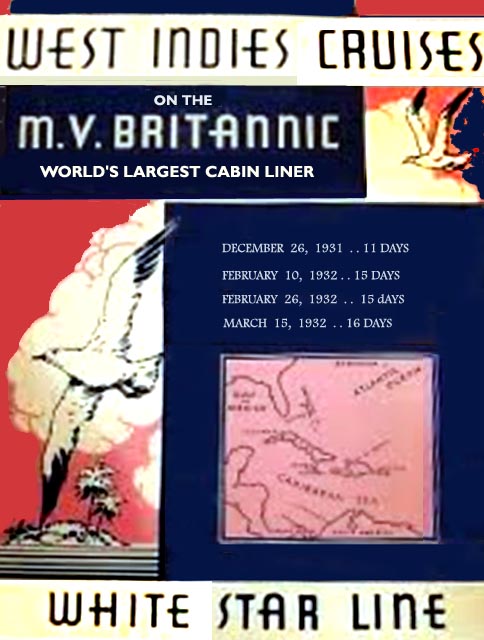 -
-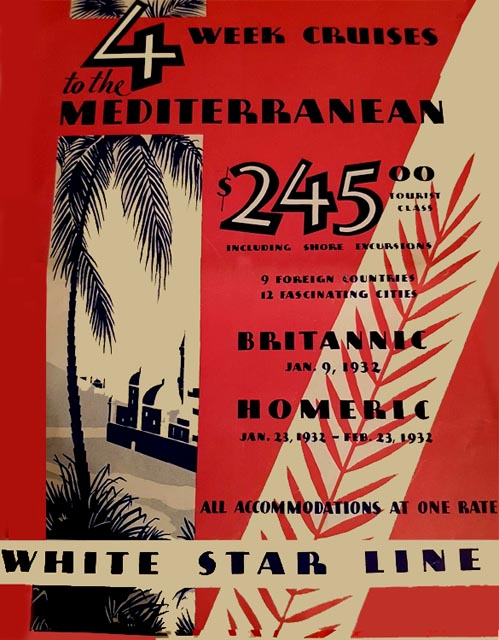
These are brochures for mostly the longer cruises
She also attracted charter trade,
such as a 16-day cruise to the
In summer the
“Britannic” shared the route with the
older R.M.S. Adriatic, “Baltic” and “Cedric”. In
1932 her running mate the M.V. Georgic entered service and
joined her on the
Amazingly during her first
15 months of service the “Britannic” averaged just 609
passengers per voyage, being less than 40 percent of her capacity. And two cruises from
Then in 1933 suddenly there was the largest number of passengers ever to sail on the “Britannic” on a single crossing, for there were 1,003 guests on board, although this was less than 65 percent of her total capacity, yet it was the highest number of any other Trans-Atlantic liner that year. It was “Britannic’s” sheer luxury and her superbly appointed Public Facilities that attracted passengers, and this helped for her to pay her way whilst so many other ships simply where unable to do the same.
On December 15, 1933 the “Britannic” ran aground on a mud flat off ‘Governors Island’ in Boston Harbour, although she was refloated the very next day with the aid of six tugboats she had no damage whatsoever.
But by that time the ‘White Star Line’ being in serious financial trouble due to their owners problems, on July 20, 1931 the Royal Mail Case opened at the ‘Old Bailey’, which led to the collapse of ‘White Star Line’s’ parent company. All this resulted in due course that on January 1, 1934 the ‘White Star Line’ had to merge with ‘Cunard’, who now held the majority of shares, in fact they now had 62 percent of ‘White Star’s’ capital.
Thus now being owned by the renamed
‘Cunard-White Star Line’ the M.V. Britannic commenced her new
service as follows; from Liverpool, Cobh, Galway,
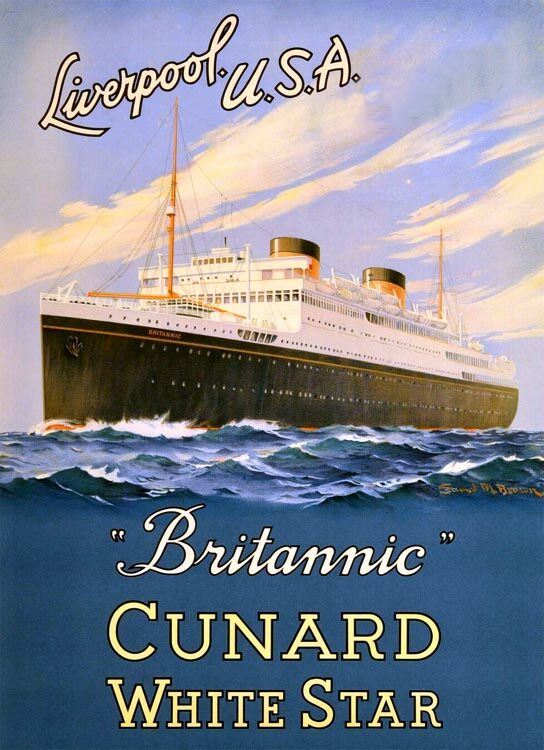
A new ‘Cunard-White Star Line’ Poster from 1934
But in April 1935 both the
“Britannic” and “Georgic” were
transferred to the -
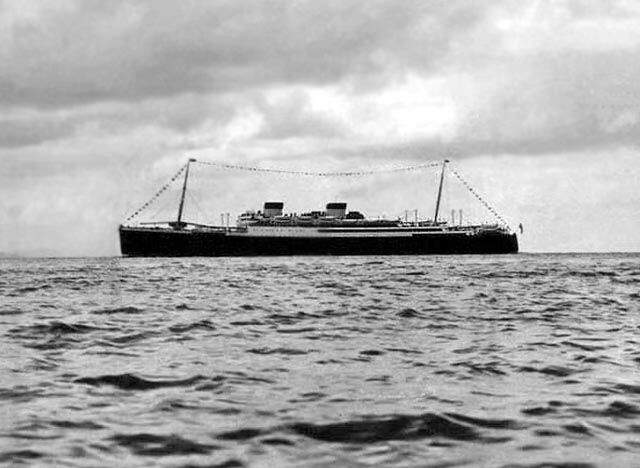
a wonderful photo of the “Britannic about to arrive at
In June
1935 “Britannic’s” Master, Captain William
Hawkes, RD, ADC, RNR, was made
a CBE. On July 22, 1935 two passengers got married aboard the
“Britannic” just before she sailed on a cruise to
By 1936 the ‘Cunard-White Star Line’ had sold most of the former ‘White Star fleet’ except “Britannic”, “Georgic” and the 18,724 GRT S.S. Laurentic of 1927.
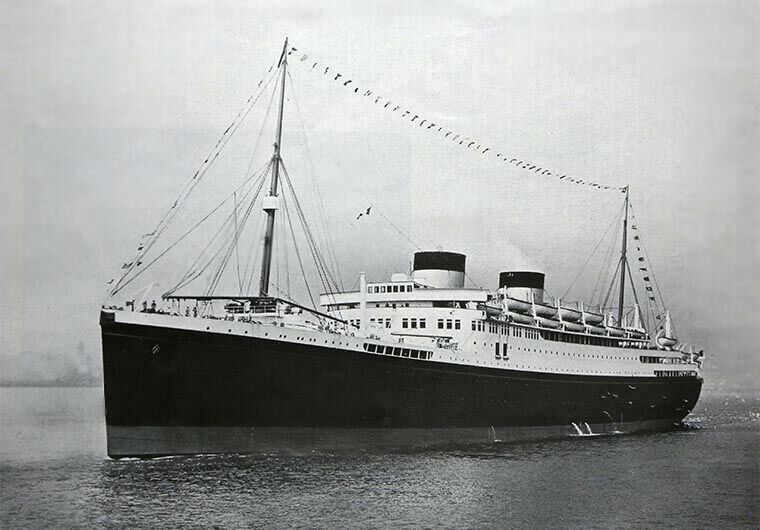
M.V. Georgic, although almost identical, the only difference
externally was her rounded forward superstructure & Bridge
Where the “Britannic was completely flat”
Again in 1936 the M.V. Britannic operated her
popular cruises, and the West Indies has now been extended to
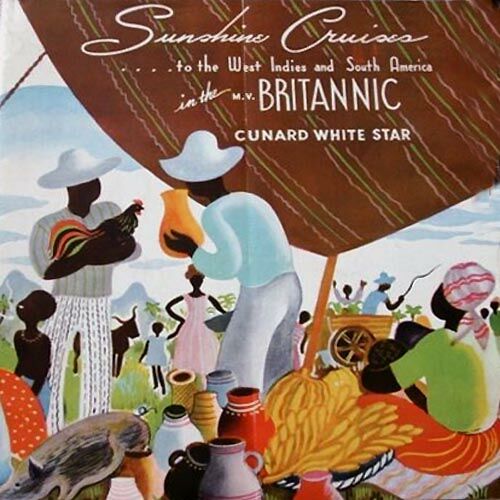
^She operated “Three Sunshine Cruises”
On January 4,
1937 Britannic suffered slight engine trouble when she arrived in
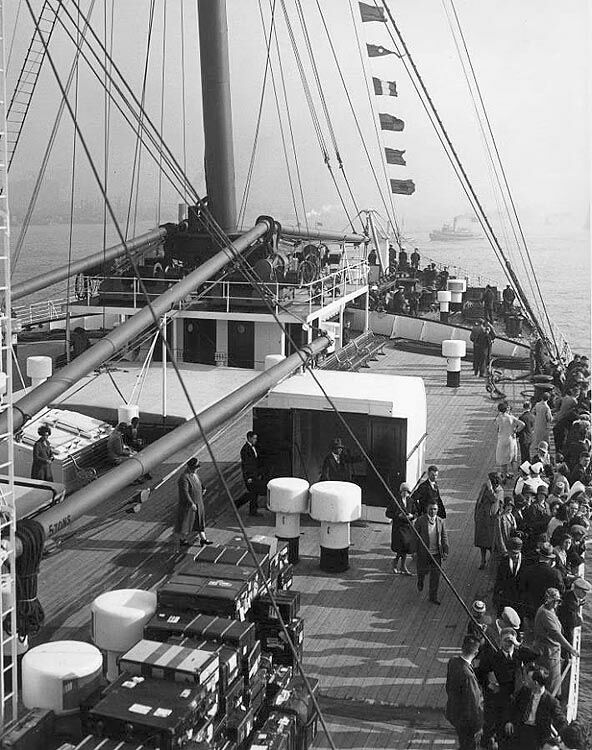
^The photograph above: Here we see the
foredeck of the M.V. Britannic late in the 1930’s as she arrives in
In October 1937 the BBC experimented
with a television receiver in one of the state rooms
on “Britannic’s” A Deck. After she left
M.V. Britannic and the “Georgic” started to face modern competition from the ‘United States Lines’ ships like the S.S. Manhattan (1932) and the S.S. Washington (1933) and French ‘CGT’ S.S. Lafayette (1930) and the S.S. Champlain (1932). In 1937 the “Britannic” carried 26,943 passengers, and the “Georgic” carried a few hundred more, but “Champlain” carried more than either of them.
Then in 1938 Britannic carried 1,170 passengers on one eastbound crossing in June, which was 75 percent of her capacity. However, on a westbound crossing in October she carried just 729 passengers.
However, it soon became clear the War was imminent
and whilst the M.V. Britannic was returning to the
To be continued on Page Two - The Index is located below the next Image.
*********************
Remembering the Superb …
M.V. Britannic
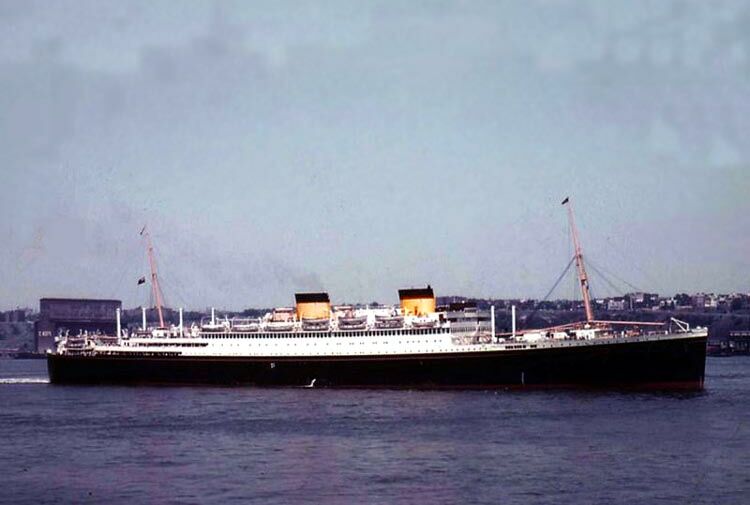
^A photograph of
the M.V. Britannic departing
*********************
M.V. Britannic INDEX:
Page
Two: WW2
service, post war refit & her years from 1947 to 1960.
Page
Three: Deck
Plans & Souvenirs, etc.
Page Four: M.V. Georgic, her newer
sister 1932 to 1956.
“Blue Water Liners sailing to the distant shores.
I watched them come, I watched
them go and I watched them die.”
Featuring over 1,435 Classic Passenger Liners, Passenger-Cargo Liners & Classic Cruise Ships!
Or ENTER HERE
For interest: Sadly an email service to ssMaritime is no longer available, due to the author’s old age and chronic illness as well as being disabled, etc. In the past ssMaritime received well over 120 emails per day, but Mr. Goossens can no longer handle same. He sincerely regrets this!
*********************
ssMaritime.com & ssMaritime.net
Where the ships of the past make history & the 1914 built M.S. Doulos Story.
The Author has been in Passenger Shipping & the Cruise Industry for well over 60 years
In addition he was the founder of “Save the Classic Liners Campaign” in 1990.
Please Note: ssmaritime and associated sites are 100% non-commercial and the author seeks no funding or favours of any shape or form, never have and never will!
Photographs on ssmaritime and associate pages are by; the author or from the author’s private collection. In addition there are some images that have been provided by Shipping Companies and private photographers or collectors. Credit is given to all contributors. However, there are some photographs provided to me without details regarding the photographer/owner concerned.
This notice covers all pages; although, and I have done my best to ensure that all photographs are duly credited and that this notice is displaced on each page, that is, when a page is updated!
ssMaritime is owned & © Copyright by Reuben Goossens - All Rights Reserved

